Sound Insulation Performance of Furfuryl Alcohol-Modified Poplar Veneer Used in Functional Plywood
Abstract
:1. Introduction
2. Materials and Methods
2.1. Poplar Veneer Specimen Preparation
2.2. Evaluation of FA Modification
2.3. Sound Insulation Characteristics
2.4. Microscopic Characterization
3. Results and Discussion
3.1. WPG and AD
3.2. Sound Insulation Performance
3.2.1. FA Concentration
3.2.2. Acid Catalyst Category
3.2.3. Solvent Category
3.3. SEM Analysis
3.4. FTIR Analysis
3.5. Surface Area and Pore Distribution
3.6. FA-Modified Veneer Sound Insulation Mechanism
4. Conclusions
- Furfuryl alcohol modification significantly increased WPG, improving the areal density of poplar veneer. The research proved that furfuryl alcohol modification improved the sound insulation performance of poplar veneer, especially in the human-sensitive frequency band, ranging from 1000 Hz to 3000 Hz. Still, the enhancement effect of furfuryl alcohol modification was not ideal at the low-frequency band.
- The optimal formulation in this experiment was modified with 50% furfuryl alcohol concentration, using isopropanol as a solvent and maleic anhydride as a catalyst. The preferred modified poplar veneer had average sound insulation of 19.05 dB, 1.6 times higher than the unmodified veneer.
- Except for the law of mass, the distribution of furfuryl alcohol inside the wood and its crosslinking reaction with wood components might be another critical factor for improving sound insulation performance. From the results of SEM and FTIR, it can be found that furfuryl alcohol modification ameliorated the cell wall distortion, indicating that the mechanical properties of the cell wall were enhanced, resulting in more transmission loss of sound waves inside. The effect of furfuryl alcohol concentration and catalyst on wood components was relatively small, while the components of furfuryl alcohol-modified veneer with different solvents were quite different.
- The furfuryl alcohol modification technology has been industrialized in Europe [34]. We proved the sound insulation potential of furfuryl alcohol-modified veneers-the primary raw material of plywood, through small batch experiments in the laboratory. Subsequently, batch trial production will be carried out, using furfuryl alcohol-modified veneers to prepare plywood with a larger format. By evaluating the sound insulation performance of the plywood, it can be used in the fields of lightweight partition walls and interior decoration. However, the production cost and target performance must be precisely matched in industrial production. Therefore, it is necessary to systematically study the relationship between furfuryl alcohol resin retention and sound propagation behavior in the future.
Author Contributions
Funding
Institutional Review Board Statement
Informed Consent Statement
Data Availability Statement
Acknowledgments
Conflicts of Interest
References
- Zhao, J.; Wang, X.M.; Chang, J.M.; Yao, Y.; Cui, Q. Sound insulation property of wood-waste tire rubber composite. Compos. Sci. Technol. 2010, 70, 2033–2038. [Google Scholar] [CrossRef]
- Hu, W.G.; Zhang, J.L. Study on static lateral load-slip behavior of single-shear stapled connections in plywood for upholstered furniture frame construction. J. Wood Sci. 2021, 67, 40. [Google Scholar] [CrossRef]
- Xiong, X.Q.; Ma, Q.R.; Yuan, Y.Y.; Wu, Z.H.; Zhang, M. Current situation and key manufacturing considerations of green furniture in China: A review. J. Clean. Prod. 2020, 267, 121957. [Google Scholar] [CrossRef]
- Negro, F.; Cremonini, C.; Zanuttini, R.; Fringuellino, M. Development of framed poplar plywood for acoustic improvement. Wood Res. 2016, 61, 121–128. [Google Scholar]
- Buratti, C.; Barellil, L.; Moretti, E. Wooden windows: Sound insulation evaluation by means of artificial neural networks. Appl. Acoust. 2013, 74, 740–745. [Google Scholar] [CrossRef]
- London, A. Transmission of reverberant sound through single walls. J. Res. Natl. Bur. Stand. 1949, 42, 2. [Google Scholar] [CrossRef]
- Reengwaree, A.; Premanond, V.; Torsakul, S. A study of energy saving in buiding through thermal insulation with plywood inserted honeycomb sandwich panels. Energy Procedia 2013, 34, 964–972. [Google Scholar] [CrossRef]
- Fan, Z.Q.; Peng, L.M.; Liu, M.H. Effect of cork-layer thickness on soundproof properties of cork/fiberboard laminate flooring. Wood Ind. 2020, 34, 17–20. [Google Scholar]
- Hua, L.S.; Chen, L.W.; Antov, P.; Kristak, L.; Tahir, P.M. Engineering wood products from Eucalyptus spp. Adv. Mater. Sci. Eng. 2022, 2022, 8000780. [Google Scholar]
- Marques, B.; Antonio, J.; Almeida, J.; Tadeu, A.; De Brito, J.; Dias, S.; Pedro, F.; Sena, J.D. Vibro-acoustic behavior of polymer-based composite materials produced with rice husk and recycled rubber granules. Constr. Build. Mater. 2020, 254, 120221. [Google Scholar] [CrossRef]
- Ghofrani, M.; Ashori, A.; Rezvani, M.H.; Ghamsari, F.A. Acoustical properties of plywood/waste tire rubber composite panels. Measurement 2016, 94, 382–387. [Google Scholar] [CrossRef]
- Efe, F.T.; Alma, M.H. Investigating some physical properties of composite board, produced from sunflower stalks, designed horizontally. Ekoloji 2014, 23, 40–48. [Google Scholar] [CrossRef]
- Liu, Y.S.; Guan, M.J. Selected physical, mechanical, and insulation properties of carbon fiber fabric-reinforced composite plywood for carriage floor. Eur. J. Wood Wood Prod. 2019, 77, 995–1007. [Google Scholar] [CrossRef]
- Liu, M.H.; PENG, L.M.; FAN, Z.Q.; Wang, D. Sound insulation and mechanical properties of wood damping composites. Wood Res. 2019, 64, 743–758. [Google Scholar]
- Fekiač, J.; Gáborík, J.; Vojtkuliak, M. Properties of plywood made from perforated veneers. Forests 2021, 12, 1709. [Google Scholar] [CrossRef]
- Jivkov, V.; Simeonova, R.; Antov, P.; Marinova, A.; Petrova, B.; Kristak, L. Structural application of lightweight panels made of waste cardboard and beech veneer. Materials 2021, 14, 5064. [Google Scholar] [CrossRef]
- Gu, Y.T.; Zhang, J.L. Fatigue performance of natural and synthetic rattan strips subjected to cyclic tensile loading. Forests 2022, 13, 76. [Google Scholar] [CrossRef]
- Chen, H.; Zhang, Y.T.; Zhong, T.H.; Wu, Z.H.; Zhan, X.X.; Ye, J.Y. Thermal insulation and hydrophobization of wood impregnated with silica aerogel powder. J. Wood Sci. 2020, 66, 81. [Google Scholar] [CrossRef]
- Hu, W.G.; Zhang, J.L. Effect of growth rings on acoustic emission characteristic signals of southern yellow pine wood cracked in mode I. Constr. Build. Mater. 2022, 329, 127092. [Google Scholar] [CrossRef]
- Wang, Y.J.; Wu, Y.; Yang, F.; Wang, J.; Zhou, J.C. A multilayer transparent wood prepared by laminating two kinds of tree species. J. Appl. Polym. Sci. 2021, 139, 51872. [Google Scholar] [CrossRef]
- Yang, L.C.; Wu, Y.; Yang, F.; Wang, W.H. Study on the preparation process and performance of a conductive, flexible, and transparent wood. J. Mater. Res. Technol. 2021, 15, 5396–5404. [Google Scholar] [CrossRef]
- Hailiq, R.; Rayudi, A.F.; Suprayitno, A. The effect of filler composition and shape to sound capability insulation and modulus elasticity natural fiber galam wood (melaleuca leucadendra)-polyester. In IOP Conference Series: Materials Science and Engineering, Proceedings of the International Conference on Mechanical Engineering Research and Application, Malang, Indonesia, 23–25 October 2018; IOP Publishing Ltd.: Bristol, UK, 2019; p. 012037. [Google Scholar]
- Li, P.; Kim, B.J.; Wang, Q.W.; Wu, Q.L. Experimental and numerical analysis of the sound insulation property of wood plastic composites (WPCs) filled with precipitated CaCO3. Holzforschung 2013, 67, 301–306. [Google Scholar] [CrossRef]
- Dong, Y.M.; Yan, Y.T.; Zhang, S.F.; Li, J.Z. Wood/polymer nanocomposites prepared by impregnation with furfuryl alcohol and nano-SiO2. BioResources 2014, 9, 6028–6040. [Google Scholar] [CrossRef]
- Esteves, B.; Nunes, L.; Pereira, H. Properties of furfurylated wood (Pinus pinaster). Eur. J. Wood Wood Prod. 2011, 69, 521–525. [Google Scholar] [CrossRef]
- Yang, T.T.; Wang, J.M.; Xu, J.Q.; Ma, E.N.; Cao, J.Z. Hygroscopicity and dimensional stability of Populus Euramericana Cv. modified by furfurylation combined with low hemicellulose pretreatment. J. Mater. Sci. 2019, 54, 13445–13456. [Google Scholar] [CrossRef]
- Dong, Y.M.; Yan, Y.T.; Zhang, S.F.; Li, J.Z.; Wang, J.J. Flammability and physical-mechanical properties assessment of wood treated with furfuryl alcohol and nano-SiO2. Eur. J. Wood Wood Prod. 2015, 73, 457–464. [Google Scholar] [CrossRef]
- Hadi, Y.S.; Westin, M. Resistance of furfurylated wood to termite attack. For. Prod. J. 2005, 55, 85–88. [Google Scholar]
- Papadopoulos, A.N.; Bikiaris, D.N.; Mitropoulos, A.C.; Kyzas, G.Z. Nanomaterials and Chemical Modifications for Enhanced Key Wood Properties: A Review. Nanomaterials 2019, 9, 607. [Google Scholar] [CrossRef]
- Mantanis, G.I. Chemical modification of wood by acetylation or furfurylation: A review of the present scaled-up technologies. BioResources 2017, 12, 4478–4489. [Google Scholar] [CrossRef]
- Leng, W.; He, S.; Zhang, X.; Zhai, S.; Wang, X.; Pan, B.; Shi, J. Research progress and thinking on the modification mechanism of wood furfurylation. J. For. Eng. 2021, 6, 35–43. [Google Scholar]
- Kang, C.W.; Jin, T.Q.; Park, H.J.; Wen, M.Y. Changes in the Dynamic and Static MOE of Furfuryl Alcohol-Treated Wood; Kyushu University Institutional Repository: Kyushu, Japan, 2015; Volume 60, pp. 203–207. [Google Scholar]
- Miao, Y.Y.; Qin, L.L.; Liu, Z.B.; Yang, L.; Lv, X.D. Effects of furfurylation on acoustic vibration performance of paulownia wood. BioResources 2018, 13, 6850–6867. [Google Scholar]
- Lande, S.; Westin, M.; Schneider, M.H. Eco-efficient wood protection: Furfurylated wood as alternative to traditional wood preservation. Manag. Environ. Qual. Int. J. 2004, 15, 529–540. [Google Scholar] [CrossRef]
- Wang, J.M.; Jiang, J. Effect of furfuryl alcohol modification on moisture adsorption of its treated wood based on response surface methodology. China For. Prod. Ind. 2022, 56, 703–720. [Google Scholar]
- ISO 12999–2:2020; Acoustics—Determination and Application of Measurement Uncertainties in Building Acoustics—Part 2: Sound Absorption. International Organization for Standardization: Geneva, Switzerland, 2020.
- Zhang, M.; Qi, Q.F.; Li, Y.W. Comparison of sound absorption coefficients of simulating calculations based on impedance tube method and reverberation chamber method. J. Acoust. Soc. Am. 2021, 41, 215–220. [Google Scholar] [CrossRef]
- Ju, Z.H.; He, Q.; Zhan, T.Y.; Zhang, H.Y.; Hong, L.; Lu, X.N. Calculation of sound insulation of softwood samples at normal incidence and comparison with experimental data. Wood Res. 2020, 65, 63–74. [Google Scholar] [CrossRef]
- Thygesen, L.G.; Ehmcke, G.; Barsberg, S.; Pilgard, A. Furfurylation result of Radiata pine depends on the solvent. Wood Sci. Technol. 2020, 54, 929–942. [Google Scholar] [CrossRef]
- Kong, L.Z. The Study on Properties of Poplar Wood Treated with Furfuryl Alcohol and Ammonium Dihydrogen Phosphate; Chinese Academy of Forestry: Beijing, China, 2018. [Google Scholar]
- Sun, S.H.; Yang, R.S.; Sun, P.Q.; Ma, C.S.; Chen, J.W. Kinetics of furfuryl alcohol condensation over acid catalyst for preparing diesel precursor. Energy 2017, 135, 577–584. [Google Scholar] [CrossRef]
- Thygesen, L.G.; Barsberg, S.; Venås, T.M. The fluorescence characteristics of furfurylated wood studied by fluorescence spectroscopy and confocal laser scanning microscopy. Wood Sci. Technol. 2009, 44, 51–65. [Google Scholar] [CrossRef]
- Acosta, A.P.; Schulz, H.R.; Barbosa, K.T.; Zanol, G.S.; Gallio, E.; Delucis, R.D.A.; Gatto, D.A. Dimensional stability and colour responses of Pinus elliottii wood subjected to furfurylation treatments. Maderas-Cienc. Tecnol. 2020, 22, 303–310. [Google Scholar] [CrossRef]
- Liu, Y.; Li, Y.Y.; Yang, X.; Wang, Y.; Xu, K.; Li, X.J.; Liu, Y. Effect of furfurylation on properties of reconstituted bamboo. J. Cent. South Univ. For. Technol. 2020, 40, 160–168. [Google Scholar]
- Wu, Y.; Zhou, J.C.; Yang, F.; Wang, Y.J.; Wang, J.; Zhang, J.L. A strong multilayered transparent wood with natural wood color and texture. J. Mater. Sci. 2021, 56, 8000–8013. [Google Scholar] [CrossRef]
- Yaddanapudi, H.S.; Hickerson, N.; Saini, S.; Tiwari, A. Fabrication and characterization of transparent wood for next generation smart building applications. Vacuum 2017, 146, 649–654. [Google Scholar] [CrossRef]
- Hadi, Y.S.; Mulyosari, D.; Herliyana, E.N.; Pari, G.; Arsyad, W.O.M.; Abdillah, I.B.; Gérardin, P. Furfurylation of wood from fast-growing tropical species to enhance their resistance to subterranean termite. Eur. J. Wood Wood Prod. 2021, 79, 1007–1015. [Google Scholar] [CrossRef]
- Barsberg, S.T.; Thygesen, L.G. A combined theoretical and FT-IR spectroscopy study of a hybrid poly(furfuryl alcohol)-lignin material: Basic chemistry of a sustainable wood protection method. ChemistrySelect 2017, 2, 10818–10827. [Google Scholar] [CrossRef]
- Fukuta, S.; Nishizawa, M.; Takasu, Y.; Ohta, Y.; Mori, T.; Yamasaki, M.; Sasaki, Y. Sound absorption and form retention of newly developed heat-insulating/acoustic material. Eur. J. Wood Wood Prod. 2012, 70, 697–704. [Google Scholar] [CrossRef]
- Li, M.J.; Ren, D.; Zhang, X.X.; Wang, H.K.; Yu, Y. The Furfurylation of Wood: A Nanomechanical Study of Modified Wood Cells. BioResources 2016, 11, 3614–3625. [Google Scholar] [CrossRef]
- Hu, W.G.; Li, S.; Liu, Y. Vibrational characteristics of four wood species commonly used in wood products. BioResources 2021, 16, 7101–7111. [Google Scholar] [CrossRef]
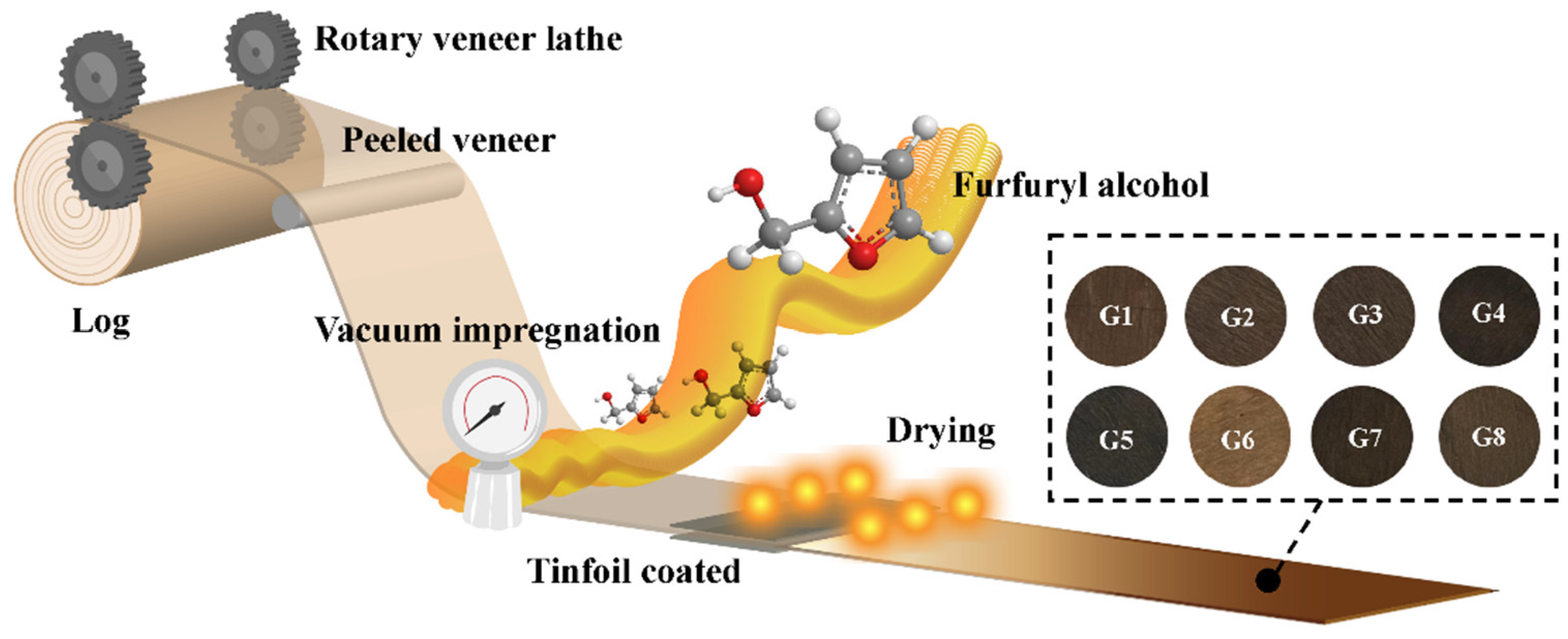
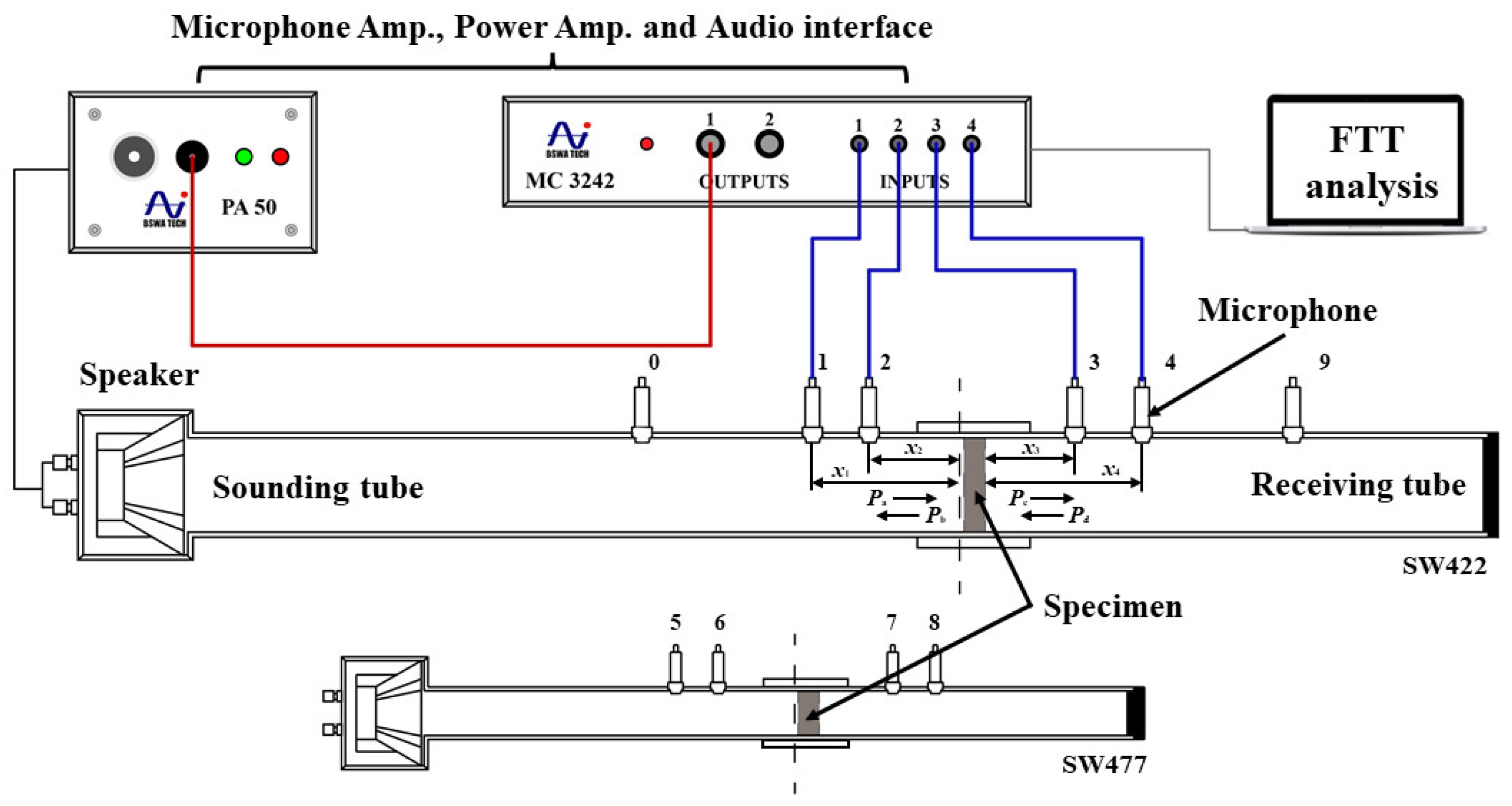

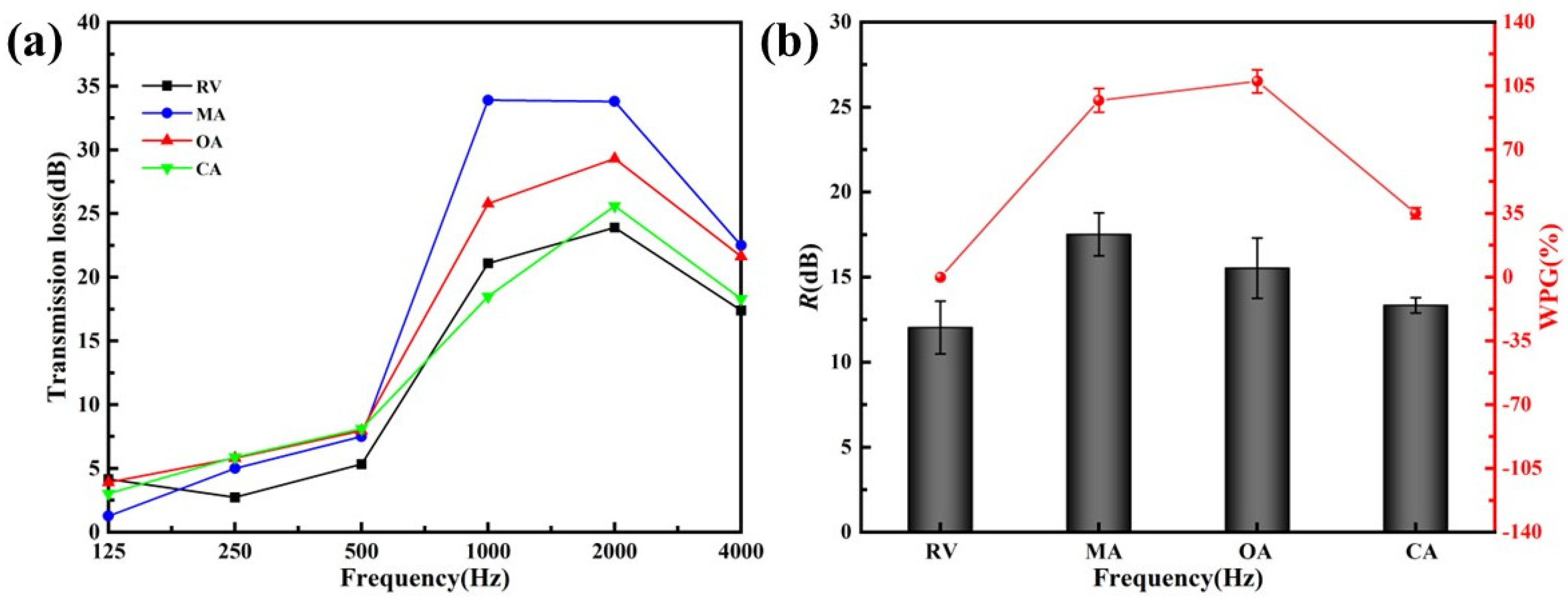
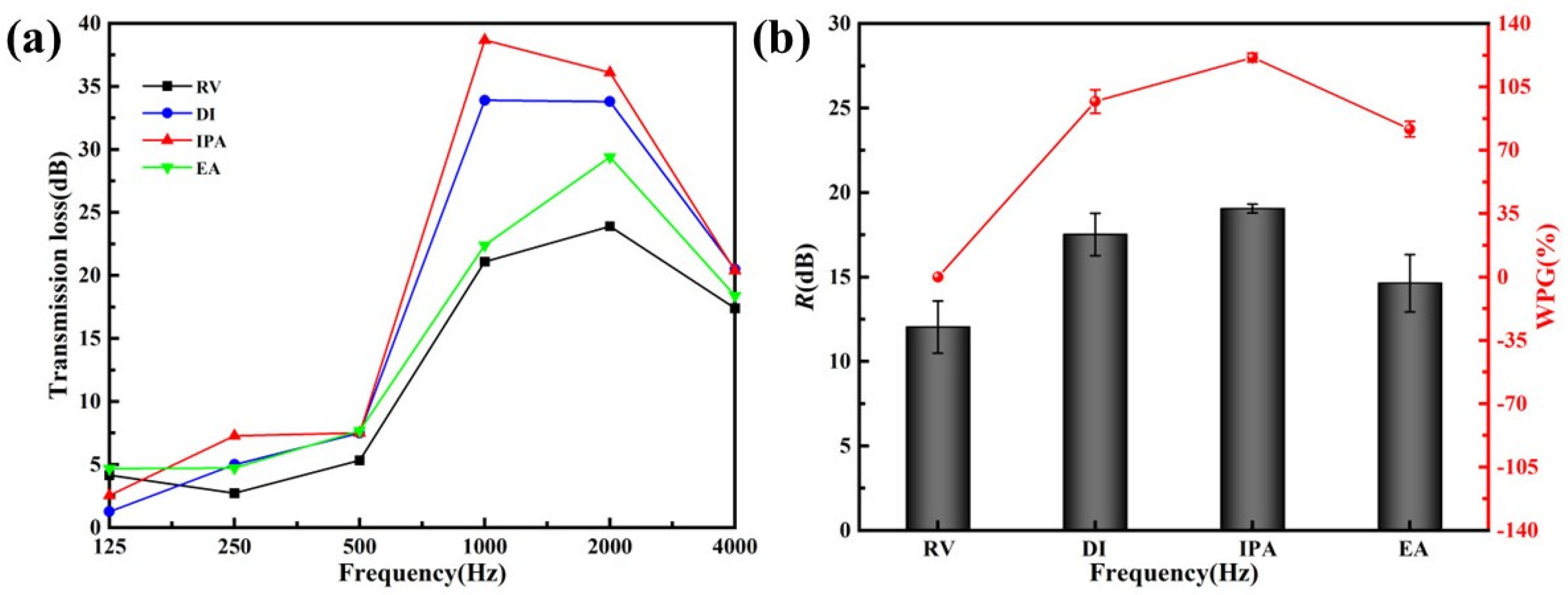
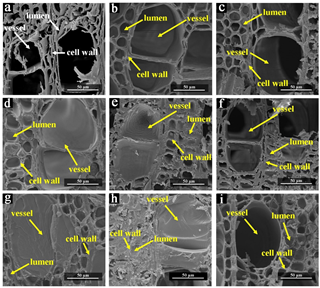
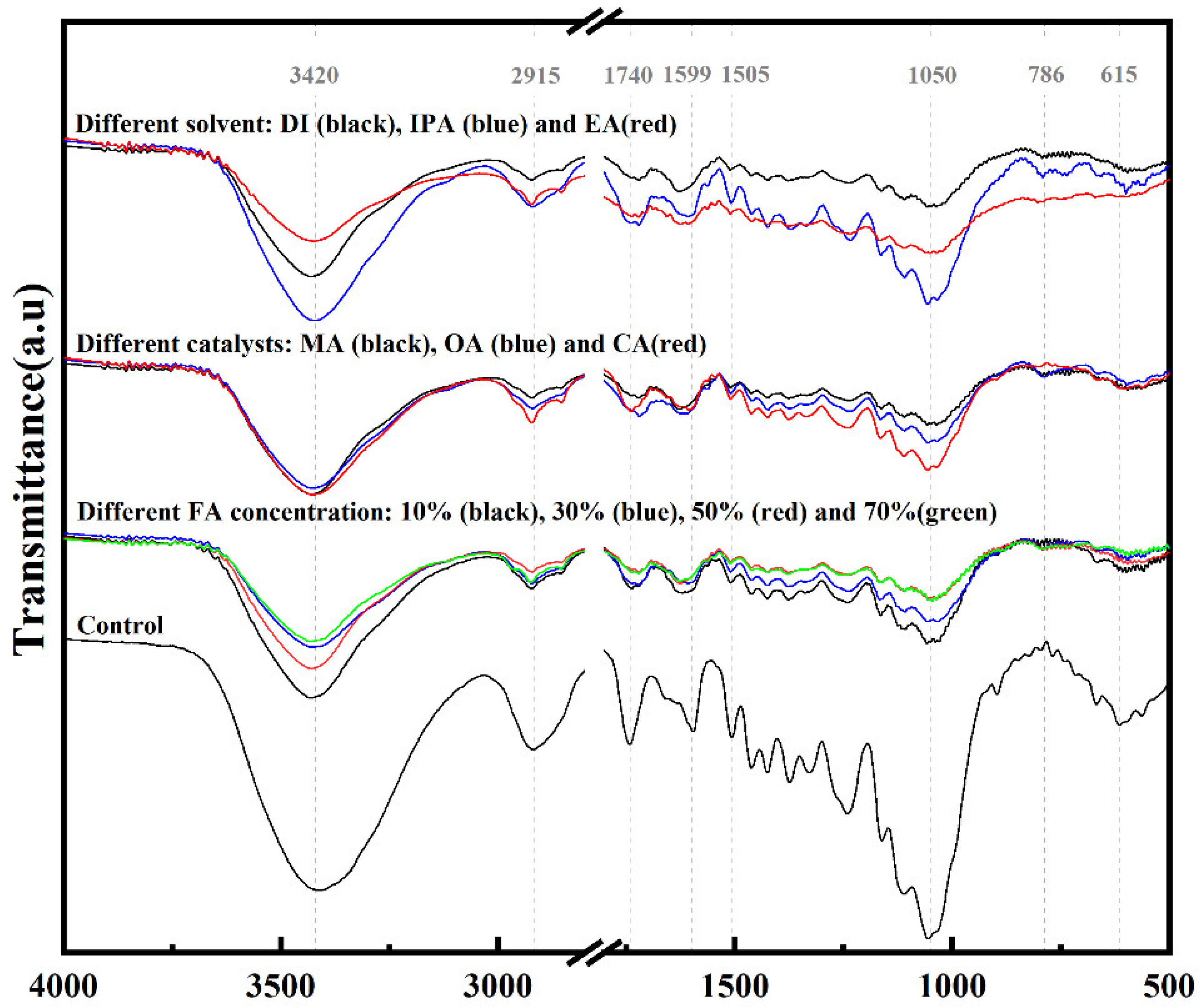
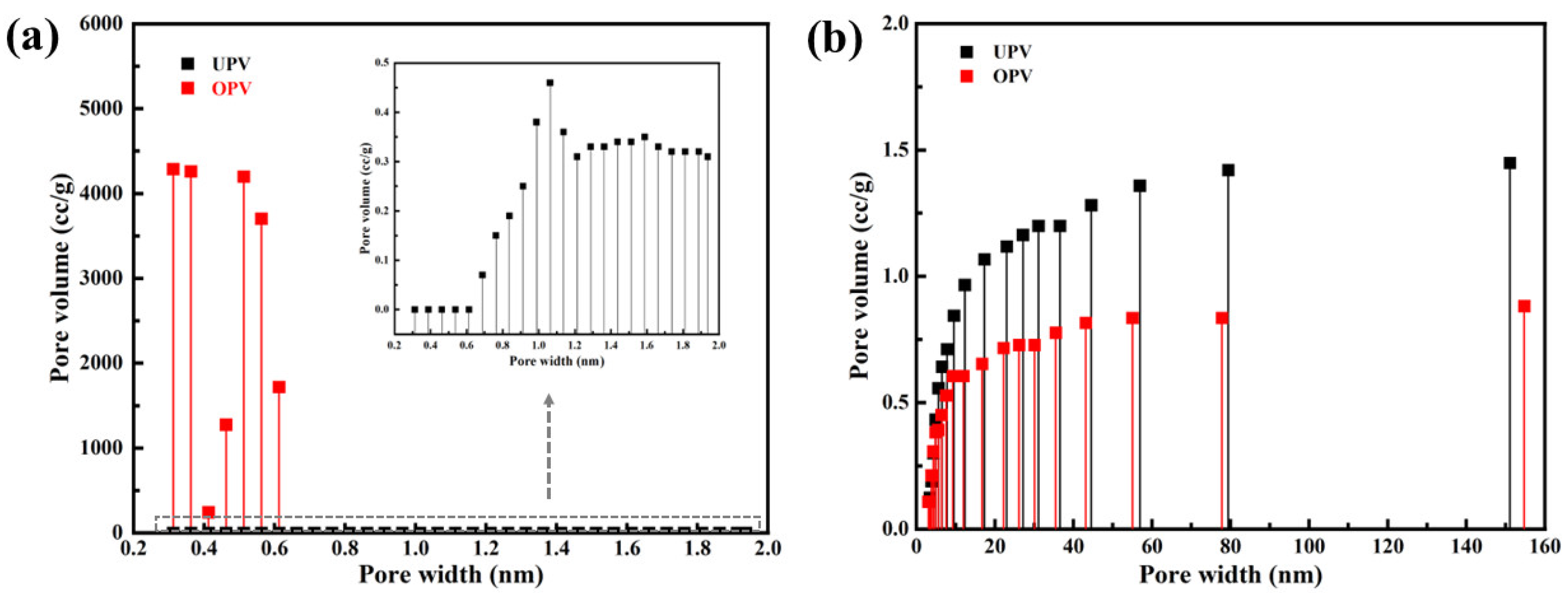

| Number | Catalyst | Solvent | ||||
|---|---|---|---|---|---|---|
| G1 | 10 | MA | 2 | 2 | DI | 86 |
| G2 | 30 | MA | 2 | 2 | DI | 66 |
| G3 | 50 | MA | 2 | 2 | DI | 46 |
| G4 | 70 | MA | 2 | 2 | DI | 26 |
| G5 | 50 | OA | 2 | 2 | DI | 46 |
| G6 | 50 | CA | 2 | 2 | DI | 46 |
| G7 | 50 | MA | 2 | 2 | IPA | 46 |
| G8 | 50 | MA | 2 | 2 | EA | 46 |
| Number | pH of FA Solution | WPG/% | AD/(kg·m−2) |
|---|---|---|---|
| Control group (RV) | / | 0 | 0.64 ± 0.01 |
| G1 | 2.5 | 22.41 ± 2.11 | 0.72 ± 0.01 |
| G2 | 3 | 53.74 ± 3.45 | 0.86 ± 0.02 |
| G3 | 3 | 97.01 ± 6.76 | 1.05 ± 0.05 |
| G4 | 3 | 113.24 ± 3.76 | 1.15 ± 0.04 |
| G5 | 2 | 107.51 ± 6.34 | 1.06 ± 0.01 |
| G6 | 3.5 | 35.08 ± 3.15 | 0.81 ± 0.04 |
| G7 | 4 | 121.28 ± 2.45 | 1.19 ± 0.04 |
| G8 | 4.5 | 81.73 ± 4.31 | 1.02 ± 0.06 |
| Wavenumber/cm−1 | Assignments of Absorption Peaks |
|---|---|
| 3420 | O-H stretching vibration in lignin |
| 2915 | C-H stretching vibration in lignin |
| 1740 | Acetyl site of hemicellulose |
| 1595 | Stretching vibration of an aromatic skeleton group of lignin |
| 1050 | C=O stretching vibration in cellulose |
| 786 | Out-of-plane deformation vibration of furan ring -CH bond |
| 615 | Out-of-plane deformation vibration of benzene ring -CH bond |
| Number | Surface Area/(m2·g−1) | Total Pore Volume/(cc·g−1) | Average Pore Diameter/nm |
|---|---|---|---|
| UPV | 3.184 | 80.98 | 4.95 |
| OPV | 3.562 | 15836.79 | 2.96 |
Publisher’s Note: MDPI stays neutral with regard to jurisdictional claims in published maps and institutional affiliations. |
© 2022 by the authors. Licensee MDPI, Basel, Switzerland. This article is an open access article distributed under the terms and conditions of the Creative Commons Attribution (CC BY) license (https://creativecommons.org/licenses/by/4.0/).
Share and Cite
Wu, S.; Xu, W. Sound Insulation Performance of Furfuryl Alcohol-Modified Poplar Veneer Used in Functional Plywood. Materials 2022, 15, 6187. https://doi.org/10.3390/ma15186187
Wu S, Xu W. Sound Insulation Performance of Furfuryl Alcohol-Modified Poplar Veneer Used in Functional Plywood. Materials. 2022; 15(18):6187. https://doi.org/10.3390/ma15186187
Chicago/Turabian StyleWu, Shuangshuang, and Wei Xu. 2022. "Sound Insulation Performance of Furfuryl Alcohol-Modified Poplar Veneer Used in Functional Plywood" Materials 15, no. 18: 6187. https://doi.org/10.3390/ma15186187





